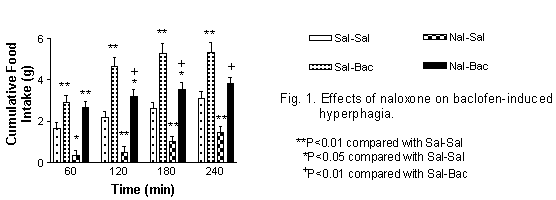| pA2 online © Copyright 2004 The British Pharmacological Society |
107P
University of Bath Summer Meeting July 2004 |
|
Effects of the opioid receptor antagonist naloxone on baclofen-induced hyperphagia in non-deprived rats S.M. Patel & I.S. Ebenezer. Neuropharmacology Research Group, School of Pharmacy and Biomedical Sciences, University of Portsmouth, Portsmouth, PO1 2DT, U.K |
|
It has previously been shown that both central and systemic administration of the GABAB receptor agonist baclofen increases food consumption in non-deprived rats (Ebenezer, 1990; Ebenezer et al., 1992). Furthermore, evidence from this laboratory suggests that endogenous central GABA, acting at GABAB receptors, plays a physiological role in the regulation of food intake (Patel et al., 2003). In recent years, attention has focused on the mesolimbic area of the brain as a possible site at which baclofen elicits its hyperphagic actions (see Ward et al., 2000). This area of the brain is involved in reward processes and it is well established that opioid agonists increase, while opioid antagonists decrease food consumption by modulating the incentive value of the food (see Williams et al., 2002). The present study was undertaken to investigate if the hyperphagic effects of baclofen involves an opioid receptor mechanism.
Male Wistar rats (n=8; b. wt. 300 – 340g) were housed in groups of 4 and had free access to food and water at all times. During experimental trials, the rats were injected i.p. with either saline (sal) followed 15 min later by sal., sal followed by baclofen (bac; 2 mg kg-1), naloxone (nal; 0.25 mg kg-1) followed by sal, or nal (0.25 mg kg-1) followed by bac (2 mg kg -1). Immediately after the 2nd injection the rats were placed singly in separate experimental cages with free access to food and water for 240 min. Cumulative food intake was measured at 60 min intervals, as described previously (Ebenezer, 1990). A repeated measures design was used with each rat receiving all treatments; 4 days separated successive drug trials. The data were analysed by ANOVA and Newman-Keuls post-hoc test. The results are illustrated in Fig. 1.Baclofen (2 mg kg-1) significantly increased cumulative food intake at each of the measurement intervals. By contrast, naloxone (0.25 mg kg-1) produced significant reductions in cumulative food intake on its own. This is of interest because others have reported no significant change in food intake compared with control data with doses up to 5 mg kg-1 (see Williams et al, 2002). Naloxone significantly reduced the baclofen-induced hyperphagia at 120, 180 and 240 min. However, ANOVA revealed no significant interactions between baclofen and naloxone at any of the measurement times. Thus, the reduction in food intake elicited in the baclofen-treated rats by naloxone was most likely due to the general anorectic action of the opioid receptor antagonist on feeding rather than by blocking the effect of baclofen on opioid recptor mechanisms. These findings therefore suggest that it is unlikely that GABA, acting at GABAB receptors, regulates feeding behaviour by interacting with an opioid system.

Ebenezer, I.S. (1990) NeuroReport, 1, 73 – 76
Ebenezer, I.S. et al. (1992) Neuropharmacol., 31, 39 – 42
Patel, S.M. et al. (2003) Br. J. Pharmacol., 140, 62P
Ward, B.O. et al. (2000) Physiol. Behav., 68, 463 – 468
Williams, C.M. et al. (2002). Pharmacol. Biochem. Behav., 71, 341 – 348